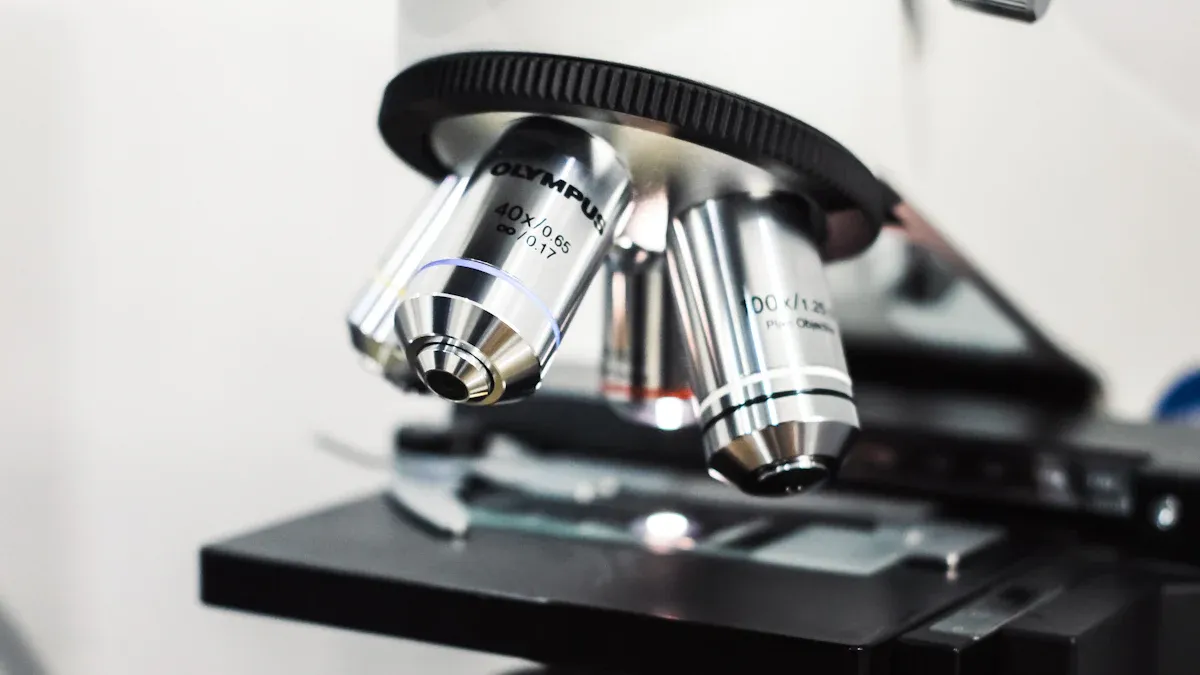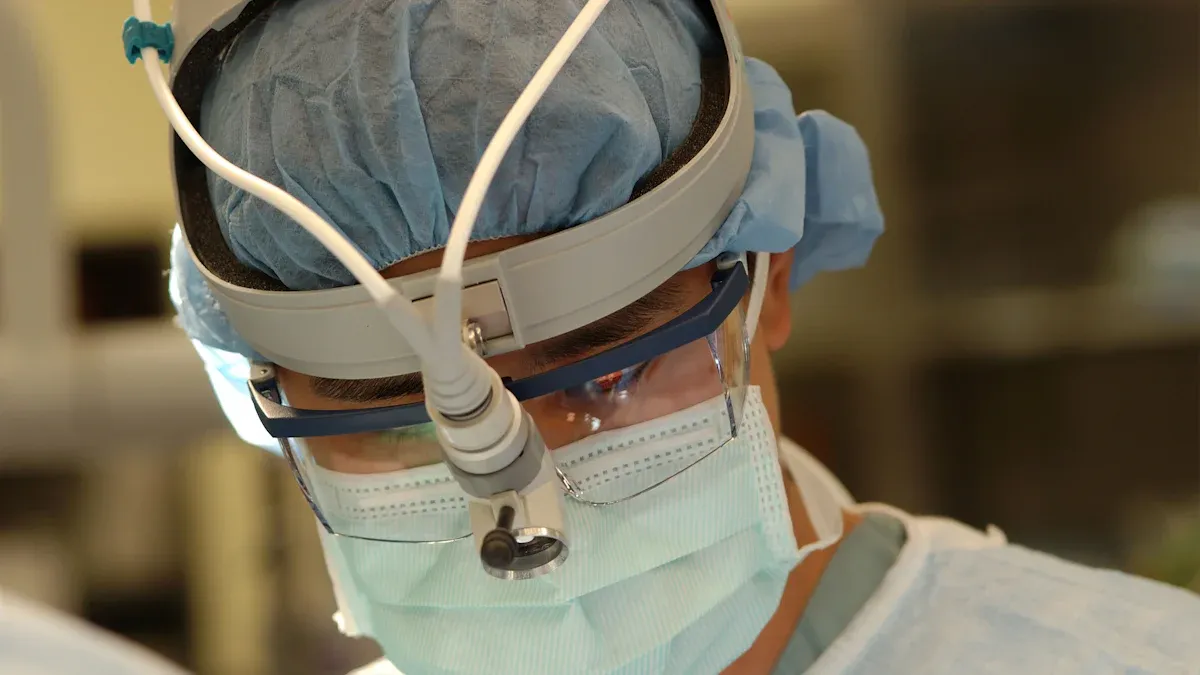What is nitinol tubing and how is it used in endoscopic clip applicators

Nitinol tubing for endoscopic clip applicators is a specialized tube made from a nickel-titanium alloy. This tubing plays a crucial role in endoscopic clip applicators by helping doctors accurately place clips during procedures. The choice of material in endoscopic devices is vital for both safety and performance. Nitinol tubing for endoscopic clip applicators offers superelasticity, shape memory, and corrosion resistance. These properties prevent the tube from bending excessively and ensure long-lasting durability. Clinical studies demonstrate that nitinol tubing for endoscopic clip applicators is highly effective for closing tissue and placing stents, which is why its use is becoming increasingly common among doctors in endoscopic procedures today.
Key Takeaways
Nitinol tubing is a special metal. It bends easily and goes back to its shape. This makes it great for medical tools. These tools need to move inside the body.
Its superelasticity and shape memory help doctors a lot. They can place clips in the right spot during endoscopic procedures. This makes things safer and works better.
Nitinol tubing does not rust. It lasts a long time. This helps medical devices work well. It also lowers risks during surgery.
This tubing is safe for patients. It lets out very little nickel. It also meets strict FDA and quality rules.
Nitinol tubing is better than stainless steel and polymers. It is more flexible, strong, and lasts longer for endoscopic clip applicators.
Nitinol Tubing Basics

What is Nitinol?
Nitinol is a metal made from nickel and titanium. The amount of nickel is controlled between 54.5% and 57.0%. This careful mix gives nitinol its special features. Superelasticity lets nitinol bend a lot and snap back to its shape. Shape memory means nitinol can go back to its shape after being bent or twisted. This happens because of a change inside the metal. The metal can switch between two solid forms called austenite and martensite. Nitinol is not brittle like some other metals. It is strong, bends easily, and does not rust. These things make nitinol tubing great for medical uses.
Did you know?
Nitinol's shape memory helps it "remember" its shape. This makes it good for tools that need to change shape inside the body.
Property/Aspect | Details/Description |
|---|---|
Nickel Content | 54.5%–57.0% for stable properties and biocompatibility. |
Shape Memory Effect | Returns to original shape after deformation. |
Bends and flexes without permanent damage. | |
Corrosion Resistance | High, due to special composition and finishing. |
Fatigue Life | Withstands repeated bending and stress. |
Dimensional Tolerances | Very tight, for precise medical device fit. |
ASTM F2063 Certification | Meets strict safety and quality standards. |
Nitinol Tubing in Medicine
Nitinol tubing is used a lot in medicine. Doctors and engineers use it in stents, guidewires, and implants. In endoscopic procedures, nitinol tubing helps tools bend and move in the body. This is important for reaching hard spots during surgery. Nitinol tubing does not wear out fast. It can bend and straighten many times without breaking.
Nitinol tubing's chemical makeup stops rust and keeps it safe for people.
The shape memory and superelasticity help tools fit the body's curves.
Tight tolerances make sure devices work well and fit right.
Surface finishing, like electropolishing, lowers nickel release and makes it safer.
Nitinol tubing lasts a long time and works well in many uses.
Studies show nitinol tubing in stents and guidewires causes fewer problems. Patients heal faster with nitinol-based stents. These stents have a 30% lower rejection rate than other metals. In endoscopic tools, nitinol tubing helps doctors move tools exactly where needed. This makes surgery safer and better. More uses for nitinol tubing are found as doctors and engineers learn about its special features.
Nitinol Tubing for Endoscopic Clip Applicators

Role in Device Design
Nitinol tubing for endoscopic clip applicators is very important. It helps doctors put clips in the right place. The tubing has superelasticity and shape memory. These features let the device move easily inside the body. Doctors use these features to guide the applicator to the right spot. The tubing can bend and flex but keeps its shape. This helps doctors be accurate during surgery.
Nitinol tubing is made from about 55% nickel and 45% titanium. It shows superelasticity and shape memory effects. These are needed for the device to work well. The tubing can bend and move without breaking. This makes sure the device works every time. The shape memory effect helps the tubing react fast when doctors use it. This gives doctors good control.
Note:
Nitinol tubing for endoscopic clip applicators does not rust. It stays strong inside the body. This keeps the device working and stops problems during long surgeries.
Studies show why nitinol tubing is good for endoscopic clip applicators:
The OTSC system uses a nitinol clip that is super-elastic and safe for the body. This helps close holes in the stomach or intestines.
Reports from Sandmann, Albert, and Repici say the OTSC system stops bleeding and fixes leaks very well.
The super-elasticity and safety of nitinol help close tissue tightly in many cases.
The strong and safe features of nitinol tubing make these devices work well.
Nitinol tubing for endoscopic clip applicators helps doctors put clips in hard places. The tubing’s design lets doctors move endoscopes through tricky body paths. This makes endoscopic surgery safer and better.
Flexibility and Strength
Nitinol tubing is known for being flexible and strong. These features help endoscopic tools move in the body without breaking. The tubing can bend a lot and go back to its shape. This is important for moving through tight curves in endoscopes.
Tests show how nitinol tubing helps devices work better:
The Bend Free Recovery (BFR) test checks if the tubing goes back to its shape after bending.
Differential Scanning Calorimetry (DSC) checks the heat needed for superelasticity.
Finite element analysis helps design bendy parts in nitinol tubes for better movement.
Nitinol tubing’s superelasticity lets tools bend a lot without damage. This helps tools like biopsy forceps and baskets work in small spaces. The tubing can return to its shape after bending. This keeps the device working well again and again.
Studies show nitinol tubing made with TM-1 processing lasts longer than TM-2 tubing. TM-1 tubing has fewer tiny bits inside, which makes it stronger. These differences help the device last longer and work better.
Material | Tensile Strength Range (MPa) | Key Mechanical Properties |
|---|---|---|
Nitinol Tubing | 500–900 | Superelasticity, Shape Memory Effect, Fatigue Resistance |
Stainless Steel | 600–1100+ | High tensile strength, Corrosion resistance |
Titanium Alloys | 900–1200 | High strength-to-weight ratio, Biocompatibility |
Nitinol tubing can handle strains over 4% and up to 6% with special processing. This means it can bend more than other metals and still go back to its shape. The mix of flexibility and strength makes nitinol tubing for endoscopic clip applicators great for lots of bending and moving.
Nitinol tubing for endoscopic clip applicators helps doctors use flexible endoscopes to reach tough spots. The tubing does not kink and stays strong. These features help doctors move tools easily and keep patients safe.
Key Properties of Nitinol
Superelasticity and Shape Memory
Nitinol tubing is special because it can bend and twist. It always goes back to its original shape. Shape memory nitinol tubes can handle up to 10% strain. This is much more than regular metals can take. Nitinol changes between two solid forms called austenite and martensite. This change is what gives nitinol its unique abilities. When doctors use shape memory nitinol tubes, the tubing can move through tight spaces. It still works well after bending.
Lab tests prove these features. Differential Scanning Calorimetry (DSC) checks the temperatures where nitinol changes form. Bend Free Recovery (BFR) tests show how well nitinol snaps back after bending. Tensile testing checks how strong and stretchy nitinol tubing is. These tests show that nitinol can handle tough medical work. Nitinol’s stress-strain curve at body temperature means it can take a lot of force. It does not get damaged easily. This makes shape memory nitinol tubes great for endoscopic tools.
Test Type | Purpose | Key Measurements/Results |
|---|---|---|
Differential Scanning Calorimetry (DSC) | Measures transformation temperatures critical for phase changes in nitinol. | Identifies martensite to austenite transformation temperatures, essential for shape memory and superelasticity. |
Bend Free Recovery (BFR) | Determines Active Austenite Finish temperature and shape recovery capability after deformation. | Measures temperature at which shape recovery completes, demonstrating functional shape memory effect. |
Tensile Testing (ASTM F2516) | Assesses mechanical properties above Active Af temperature to reveal superelastic behavior. | Records upper and lower plateau strengths, residual elongation, and stress-induced martensitic transformation during cyclic loading/unloading. |
Biocompatibility and FDA Approval
Medical-grade nitinol tubing is safe for people. Shape memory nitinol tubes have a thin oxide layer on them. This layer stops nickel from leaking out. That keeps patients safe. Studies show that finished nitinol tubing releases very little nickel. It is much less than what people eat in food. This makes shape memory nitinol tubes a good choice for endoscopic clip applicators.
FDA approval and ISO 13485 certification are very important. These rules make sure nitinol is safe, strong, and reliable. In studies, nitinol tubing worked well 97% of the time. It was also safe for a long time, with a 96.7% safety rate. These results show that shape memory nitinol tubes last and work well. Hospitals and doctors trust medical-grade nitinol because it follows all safety rules.
Metric / Aspect | Evidence / Result |
|---|---|
Technical success rate | 97% success in clinical applications (70 of 72 patients), demonstrating high reliability of ASTM F2063 certified nitinol tubing. |
Sustained aneurysm occlusion | 96.7% occlusion rate at 12 months (29 of 30 patients), indicating long-term safety and effectiveness. |
FDA clearance and compliance | FDA registration and ISO 13485 certification are essential for ensuring product safety and quality. |
Quality Control
Quality control for nitinol tubing is very strict. Makers follow rules like ISO 10993-1 and ASTM F2063. These rules make sure nitinol tubes are pure and safe. Every batch of nitinol tubing is tested for strength, stretchiness, and corrosion resistance. For example, corrosion resistance tests show nitinol tubing can handle over 600 mV. Nickel ion release drops from 6.0 µg/day to 0.2 µg/day by day 35. This is much lower than safety limits.
Surface treatments like electropolishing make nitinol tubing safer. These treatments lower nickel release and make the tubing smoother. Biological tests check for cell safety, irritation, and blood safety. All results must meet FDA and ISO rules. Good records and tracking help doctors trust the tubing’s quality. Shape memory nitinol tubes must pass every test before being used.
Cytotoxicity tests show no bad effects.
Nickel ion release stays below harmful levels.
Long-term studies show tissue stays healthy.
Electropolished nitinol tubes lower bad reactions.
All tests follow FDA and ISO rules.
Shape memory alloy technology and medical-grade nitinol make endoscopic clip applicators safer. Quality control makes sure every nitinol tube is safe for patients.
Safety and Patient Safety
Clinical Benefits
Nitinol tubing helps make surgery safer for patients. Doctors use these devices because they lower risks during surgery. The tubing can bend and move easily. This lets doctors reach hard spots without hurting other areas. Its flexibility makes surgery less invasive and more accurate. This helps keep patients safe.
Groups like the FDA watch how nitinol tubing works over time. They collect information from studies and real surgeries. For example, research shows nitinol stents help people live longer. Patients also need fewer repeat surgeries. The table below shows how well nitinol-based implants work for many years:
Time Point | Kaplan–Meier Estimated Survival | Freedom from Reintervention |
|---|---|---|
1 year | 94.8% | 90% |
3 years | 82.6% | 82.4% |
5 years | 68.1% | 78.1% |
These numbers show that nitinol tubing helps patients heal better. Doctors see fewer problems and better results with these devices.
Tip:
Watching how devices work over time helps doctors find rare problems early. This keeps patient safety as the main goal.
Allergy and Durability
Nitinol tubing protects against allergies and breaking. It has a special layer that stops too much nickel from coming out. This lowers the chance of allergic reactions. Most people do not have problems. But people with nickel allergies should talk to their doctor first.
Nitinol tubing is also very strong. It can bend over 10 million times and not break. This means it stays in good shape even after lots of use. Electropolished nitinol tubing does not rust, so it lasts longer in the body.
Aspect | Evidence Summary |
|---|---|
Fatigue Resistance | Handles over 10 million to 1 billion bends without breaking. |
Corrosion Resistance | Keeps its shape and lowers nickel release for a long time. |
Biocompatibility | Causes little swelling and few problems in studies. |
Clinical Outcomes | Works well and closes blood vessels safely in brain treatments. |
Allergy Incidence | Special layer lowers allergy risk; people with nickel allergy should ask their doctor. |
Nitinol tubing helps keep patients safe during and after surgery. Its strength and safety help patients feel better through the whole treatment.
Nitinol vs. Other Materials
Stainless Steel Comparison
Nitinol tubing is different from stainless steel in endoscopic clip applicators. Nitinol can bend a lot and go back to its shape. It bends up to 8% and still returns to normal. Stainless steel cannot do this. Doctors like nitinol tubing because it bends in tight or curved places. It does not break when bent. Stainless steel is strong and does not rust easily. But it is not as flexible as nitinol.
The table below shows how nitinol tubing and stainless steel are different in medical devices:
Property / Material | Nitinol SE508 (Superelastic NiTi Alloy) | Stainless Steel (Medical Grade) |
|---|---|---|
Superelastic strain | Up to 8% elastic deformation | N/A |
Stress for superelasticity | 400 - 500 MPa | Lower elastic limits |
Tensile strength (welded) | > 800 MPa | Varies by grade |
Corrosion resistance | High | Good |
Machinability | Poor | Good |
Welding challenges | Difficult | Easier |
Studies show nitinol stents work well for aneurysms. They help up to 89% of patients in 18 months. Nitinol tubing lasts longer because it does not wear out fast. Stainless steel is easier to cut and weld. But nitinol’s special features make it better for many endoscopic uses.
Polymers Comparison
Nitinol tubing is also better than polymers in many ways. Nitinol tubing bends, remembers its shape, and stretches a lot. These features help it move in the body without kinking or breaking. Polymers can get weak and break under stress. They may not last as long. Nitinol tubing stays strong and keeps its shape after many uses.
Nitinol tubing lasts longer than polymers, which can break if bent a lot.
Nitinol tubing is safer for the body and causes fewer problems.
Nitinol tubing does not rust as much as most polymers.
Polymer stents are easier to take out but can fail or move more.
Doctors pick nitinol tubing because it works well for a long time. Special treatments, like electropolishing, make nitinol tubing smoother and safer. Nitinol tubing costs more and is harder to make than polymers or stainless steel. Still, nitinol tubing is the best choice for endoscopic clip applicators. It is flexible, strong, and safe.
Nitinol tubing is the best pick for endoscopic clip applicators. Its shape memory and superelasticity help doctors close tissue well. These features work even in hard cases. Nitinol tubing does not rust or wear out fast. This makes devices last longer and work better for patients. As new tools and methods come out, nitinol tubing keeps making devices better. Medical teams should think about new materials when picking tools. This helps make care safer and more effective.
FAQ
What makes nitinol tubing different from other metals in medical devices?
Nitinol tubing can bend and then go back to its shape. This helps doctors use tools in small or tight places. Nitinol tubing does not rust and lasts longer than many metals.
Can nitinol tubing be used in biopsy devices or retrieval devices?
Yes, nitinol tubing is used in many biopsy and retrieval devices. Its flexibility and strength help these tools reach tissue or remove things safely.
Is nitinol tubing safe for people with metal allergies?
Most people do not have problems with nitinol tubing. The tubing has a special layer that keeps nickel from coming out. People who know they have nickel allergies should talk to their doctor first.
How does nitinol tubing improve endoscopic clip applicators?
Nitinol tubing lets endoscopic clip applicators bend and move inside the body. This helps doctors put clips in the right spot. The tubing is strong and does not kink during use.
Why do doctors prefer nitinol tubing for endoscopic tools?
Doctors like nitinol tubing because it is flexible, strong, and safe. It helps them do procedures with less risk. Nitinol tubing works well in many medical devices.
See Also
The Importance Of Nitinol Tubing In Minimally Invasive Surgery
The Process Behind Manufacturing Nitinol Tubing For Medicine
A Deep Dive Into Nitinol Tubing Uses In Medical Devices

